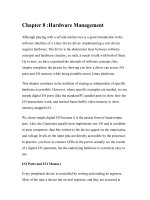Chapter 8 v7 0
Bạn đang xem bản rút gọn của tài liệu. Xem và tải ngay bản đầy đủ của tài liệu tại đây (1.54 MB, 130 trang )
©1996-2016, J.F Kurose and K.W. Ross
Computer Networks
Lectured by:
Nguyen Le Duy Lai
()
Computer
Networking: A Top
Down Approach
7th Edition, Global Edition
Jim Kurose, Keith Ross
Pearson
April 2016
Security
6-1
©1996-2016, J.F Kurose and K.W. Ross
Chapter 8
Security
Computer
Networking: A Top
Down Approach
7th Edition, Global Edition
Jim Kurose, Keith Ross
Pearson
April 2016
Security 8-2
Chapter 8: Network Security
Chapter goals:
Đ understand principles of network security:
ã cryptography and its many uses beyond confidentiality
ã authentication
ã message integrity
â1996-2016, J.F Kurose and K.W. Ross
Đ security in practice:
ã firewalls and intrusion detection systems (IDS)
• security in application, transport, network, link layers
Security 8-3
©1996-2016, J.F Kurose and K.W. Ross
Chapter 8: roadmap
8.1 What is network security?
8.2 Principles of cryptography
8.3 Message integrity and digital signatures
8.4 End-point authentication
8.5 Securing e-mail
8.6 Securing TCP connections: SSL
8.7 Network layer security: IPsec and VPNs
8.8 Securing wireless LANs
8.9 Operational security: firewalls and IDS
Security 8-4
What is network security?
©1996-2016, J.F Kurose and K.W. Ross
confidentiality: only sender, intended receiver should
“understand” message contents
• sender encrypts message
• receiver decrypts message
authentication: sender, receiver want to confirm identity of
each other
message integrity: sender, receiver want to ensure message
not altered (in transit, or afterwards) without detection
access and availability: services must be accessible and
available to users
Security 8-5
Friends and enemies: Alice, Bob, Trudy
§ well-known in network security world
§ Bob, Alice (lovers!) want to communicate “securely”
§ Trudy (intruder) may intercept, delete, add messages
Alice
Bob
©1996-2016, J.F Kurose and K.W. Ross
channel
data
data, control
messages
secure
receiver
secure
sender
data
Trudy
Security 8-6
©1996-2016, J.F Kurose and K.W. Ross
Who might Bob, Alice be?
§ … well, real-life Bobs and Alices!
§ Web browser/server for electronic transactions
(e.g., on-line purchases)
§ on-line banking client/server
§ DNS servers
§ routers exchanging routing table updates
§ other examples?
Security 8-7
©1996-2016, J.F Kurose and K.W. Ross
There are bad guys (and girls) out there!
Q: What can a “bad guy” do?
A: A lot! See section 1.6
• eavesdrop: intercept messages
• actively insert messages into connection
• impersonation: can fake (spoof) source address in
packet (or any field in packet)
• hijacking: “take over” ongoing connection by
removing sender or receiver, inserting himself in
place
• denial of service: prevent service from being used
by others (e.g., by overloading resources)
Security 8-8
©1996-2016, J.F Kurose and K.W. Ross
Chapter 8 roadmap
8.1 What is network security?
8.2 Principles of cryptography
8.3 Message integrity and digital signatures
8.4 End-point authentication
8.5 Securing e-mail
8.6 Securing TCP connections: SSL
8.7 Network layer security: IPsec and VPNs
8.8 Securing wireless LANs
8.9 Operational security: firewalls and IDS
Security 8-9
The language of cryptography
Alice’s
K encryption
A
key
©1996-2016, J.F Kurose and K.W. Ross
plaintext
encryption
algorithm
Bob’s
K decryption
Bkey
ciphertext
decryption
algorithm
plaintext
m plaintext message
KA(m) ciphertext, encrypted with key KA
m = KB(KA(m))
Security 8-10
©1996-2016, J.F Kurose and K.W. Ross
Breaking an encryption scheme
§ cipher-text only attack:
Trudy has ciphertext she
can analyze
Đ two approaches:
ã brute force: search
through all keys
ã statistical analysis
Đ known-plaintext attack:
Trudy has plaintext
corresponding to ciphertext
ã e.g., in monoalphabetic
cipher, Trudy determines
pairings for a,l,i,c,e,b,o,
Đ chosen-plaintext attack:
Trudy can get ciphertext for
chosen plaintext
Security 8-11
Symmetric key cryptography
KS
KS
©1996-2016, J.F Kurose and K.W. Ross
plaintext
message, m
encryption
algorithm
ciphertext
K
S
(m)
decryption
algorithm
plaintext
m = KS(KS(m))
symmetric key crypto: Bob and Alice share same (symmetric)
key: K S
§ e.g., key is knowing substitution pattern in mono alphabetic
substitution cipher
Q: how do Bob and Alice agree on key value?
Security 8-12
Simple encryption scheme
substitution cipher: substituting one thing for another
©1996-2016, J.F Kurose and K.W. Ross
§ monoalphabetic cipher: substitute one letter for another
plaintext:
abcdefghijklmnopqrstuvwxyz
ciphertext:
mnbvcxzasdfghjklpoiuytrewq
e.g.:
Plaintext: bob. i love you. alice
ciphertext: nkn. s gktc wky. mgsbc
Encryption key: mapping from set of 26 letters
to set of 26 letters
Security 8-13
A more sophisticated encryption approach
§ n substitution ciphers, M1,M2,…,Mn
§ cycling pattern:
ã e.g., n=4: M1,M3,M4,M3,M2; M1,M3,M4,M3,M2; ..
Đ for each new plaintext symbol, use subsequent
substitution pattern in cyclic pattern
©1996-2016, J.F Kurose and K.W. Ross
• dog: d from M1, o from M3, g from M4
Encryption key: n substitution ciphers, and cyclic pattern
• key need not be just n-bit pattern
Security 8-14
Symmetric key crypto: DES
DES: Data Encryption Standard
US encryption standard [NIST 1993]
56-bit symmetric key, 64-bit plaintext input
block cipher with cipher block chaining
how secure is DES?
• DES Challenge: 56-bit-key-encrypted phrase decrypted
(brute force) in less than a day
ã no known good analytic attack
Đ making DES more secure:
• 3DES: encrypt 3 times with 3 different keys
â1996-2016, J.F Kurose and K.W. Ross
Đ
Đ
Đ
Đ
Security 8-15
Symmetric key
crypto: DES
â1996-2016, J.F Kurose and K.W. Ross
DES operation
Đ initial permutation
§ 16 identical “rounds” of
function application,
each using different 48
bits of key
§ final permutation
Security 8-16
©1996-2016, J.F Kurose and K.W. Ross
AES: Advanced Encryption Standard
§ symmetric-key NIST standard, replaced DES
(Nov 2001)
§ processes data in 128 bit blocks
§ 128, 192, or 256 bit keys
§ brute force decryption (try each key) taking 1 sec
on DES, takes 149 trillion years for AES
Security 8-17
Public Key Cryptography
symmetric key crypto
â1996-2016, J.F Kurose and K.W. Ross
Đ requires sender, receiver
know shared secret key
§ Q: how to agree on key in
first place (particularly if
never “met”)?
public key crypto
§ radically different
approach [DiffieHellman76, RSA78]
§ sender, receiver do not
share secret key
§ public encryption key
known to all
§ private decryption key
known only to receiver
Security 8-18
Public key cryptography
+
KB Bob’s public
key
©1996-2016, J.F Kurose and K.W. Ross
K
plaintext
message, m
encryption
algorithm
ciphertext
+
B
K (m)
- Bob’s private
B key
decryption
algorithm
plaintext
message
+
m = KB (K (m))
B
Security 8-19
Public key encryption algorithms
requirements:
.
.
B
+ ( ) and K - ( ) such that
need
K
1
B
-
+
B
B
©1996-2016, J.F Kurose and K.W. Ross
K (K (m)) = m
2 given public key K +, it should be
B
impossible to compute private
key K
B
RSA: Rivest, Shamir, Adelson algorithm
Security 8-20
Prerequisite: modular arithmetic
§ x mod n = remainder of x when divide by n
Đ facts:
â1996-2016, J.F Kurose and K.W. Ross
[(a mod n) + (b mod n)] mod n = (a+b) mod n
[(a mod n) - (b mod n)] mod n = (a-b) mod n
[(a mod n) * (b mod n)] mod n = (a*b) mod n
§ thus
(a mod n)d mod n = ad mod n
§ example: x=14, n=10, d=2:
(x mod n)d mod n = 42 mod 10 = 6
xd = 142 = 196 xd mod 10 = 6
Security 8-21
©1996-2016, J.F Kurose and K.W. Ross
RSA: getting ready
§ message: just a bit pattern
§ bit pattern can be uniquely represented by an
integer number
§ thus, encrypting a message is equivalent to
encrypting a number
example:
§ m= 10010001. This message is uniquely represented by
the decimal number 145.
§ to encrypt m, we encrypt the corresponding number,
which gives a new number (the ciphertext).
Security 8-22
RSA: Creating public/private key pair
1. choose two large prime numbers p, q.
(e.g., 1024 bits each)
2. compute n = pq, z = (p-1)(q-1)
©1996-2016, J.F Kurose and K.W. Ross
3. choose e (with e
4. choose d such that ed-1 is exactly divisible by z.
(in other words: ed mod z = 1 ).
5. public key is (n,e). private key is (n,d).
+
KB
-
KB
Security 8-23
RSA: encryption, decryption
0. given (n,e) and (n,d) as computed above
©1996-2016, J.F Kurose and K.W. Ross
1. to encrypt message m (
2. to decrypt received bit pattern, c, compute
m = c d mod n
magic m = (me mod n) d mod n
happens!
c
Security 8-24
RSA example:
Bob chooses p=5, q=7. Then n=35, z=24.
e=5 (so e, z relatively prime).
d=29 (so ed-1 exactly divisible by z).
©1996-2016, J.F Kurose and K.W. Ross
encrypting 8-bit messages.
encrypt:
decrypt:
bit pattern
m
e
m
0000l000
12
24832
c
17
c
d
481968572106750915091411825223071697
c = me mod n
17
m = cd mod n
12
Security 8-25









